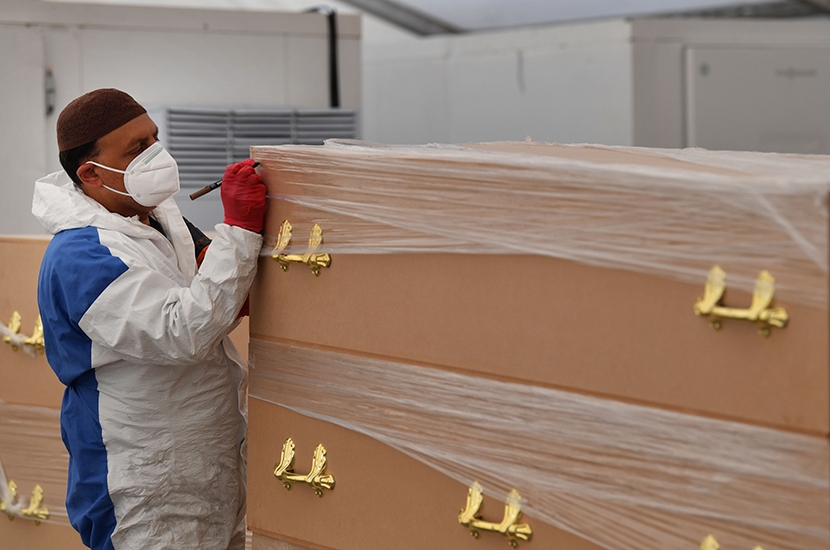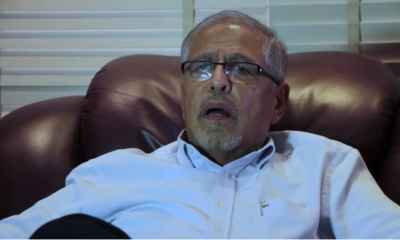Coronavirus
Pathologist: Count for nothing We have no idea how many ‘Covid deaths’ were actually Covid

By Dr. John Lee
As a pathologist, I’m used to people thinking that my job mainly involves dealing with death. But nothing could be further from the truth. That is why I and many of my colleagues are so dismayed by changes introduced during the coronavirus epidemic which mean that pathology has not been able to play the role that it should have in helping to understand this new disease.
The word ‘pathology’ tends to conjure up images of body bags, mortuaries and murder investigations. ‘Ho ho,’ people say, ‘your patients can’t answer back.’ They imagine days spent trudging across fields to reach murder scenes, Silent Witness-style, and nights sifting through arcane evidence to catch the perpetrators. And a rare type of pathologist — the forensic pathologist — does indeed do that.
Most pathologists, though, spend the majority of their careers looking after the living. After all, pathology is the study of disease, and the whole point of knowing about diseases is to inform our approaches to preventing and treating them.
There are four main types of pathologist. Microbiologists specialise in the study of infectious diseases — a subtype is the virologist, in particular demand at the moment. Chemical pathologists are experts in the liquid parts of the blood; they analyse the endless samples that pour into path labs day and night, looking for changes in chemicals and hormones that indicate disease. Haematologists are experts in diseases of the blood cells, the red cells and white cells that can cause problems such as anaemia or leukaemia.
And then there is my own speciality of histopathology, or cellular pathology. We are experts in analysing changes in the fabric of our bodies that result from disease. Many diseases affect our tissues in ways that can be seen down the microscope, allowing them to be accurately diagnosed and monitored, particularly tumours and inflammations. Every time a biopsy or surgical sample is taken, it comes to the histopathology lab to be examined. Histopathology is often regarded as a ‘gold standard’ for diagnosis of diseases that change tissue structure. A clinical examination or X-ray may suggest that a tumour or fibrosis of the lung, say, is present, but you need to examine a tissue sample microscopically to be sure that it’s really there, what type it is, and how advanced. Tissue can also be examined genetically to look for the presence of infectious agents or cellular receptors that may determine how deadly it is.
The other thing that some histopathologists do is autopsies — hence the confusion with forensic pathology. But in this case the autopsies are not typically looking for evidence of foul play. They are usually requested by a coroner to ascertain the cause of death. Relatives, even doctors, are often surprised by the need for this in the world of modern medicine. Surely all the examinations, tests and imaging carried out in life mean that the treating doctors know what was wrong with the patient when they die? But no, it turns out that autopsies often reveal the unexpected. Tests and images can be misleading, and treating doctors may have fixed ideas about what the matter is, based on first impressions or incomplete evidence.
Autopsy — auto opsis — literally means seeing for oneself. And the person doing the seeing should be clear-eyed — an independent specialist medical practitioner, with no emotional or professional vested interest in what happened to the patient. Autopsy studies typically show major discrepancies between actual findings and clinical diagnosis in a quarter to a third of cases. And in about a sixth of the cases, knowing about these hidden pathologies in life could have made differences to treatment that might have prevented death. In the UK in recent decades about one in six deaths have had an autopsy examination — a deceased person’s last gift to the living.
The results contribute to maintaining and improving care, verifying and upholding the standards of public health statistics, preventing diagnostic drift, and basically keeping medicine honest. Autopsies also allow sampling of tissues from more organs than is usually possible in life, facilitating molecular and genetic studies.
And nowhere are autopsy studies more important than in the study of new diseases and new treatments. The best example of this in recent years was acquired immune deficiency syndrome, or Aids. When Aids first appeared in the early 1980s no one knew what it was, how it affected victims, how to treat it, or what effects potential treatments had. Knowledge about all of these aspects was substantially acquired by study of tissue samples taken during life, and by autopsy examinations, with study of samples acquired after death. There was much uncertainty and worry at the time about how the disease was spread, and possible contagion to healthcare workers and to the general population. But work continued, and the results were of immense help in understanding the disease and developing treatments.
Looking at the current crisis, the response so far has been very different. We are still struggling to understand coronavirus. I can think of no time in my medical career when it has been more important to have accurate diagnosis of a disease, and understanding of precisely why patients have died of it. Yet very early on in the epidemic, rules surrounding death certification were changed — in ways that make the statistics unreliable. Guidance was issued which tends to reduce, rather than increase, referrals for autopsy.
Normally, two doctors are needed to certify a death, one of whom has been treating the patient or who knows them and has seen them recently. That has changed. For Covid-19 only, the certification can be made by a single doctor, and there is no requirement for them to have examined, or even met, the patient. A video-link consultation in the four weeks prior to death is now felt to be sufficient for death to be attributed to Covid-19. For deaths in care homes the situation is even more extraordinary. Care home providers, most of whom are not medically trained, may make a statement to the effect that a patient has died of Covid-19. In the words of the Office for National Statistics, this ‘may or may not correspond to a medical diagnosis or test result, or be reflected in the death certification’. From 29 March the numbers of ‘Covid deaths’ have included all cases where Covid-19 was simply mentioned on the death certificate — irrespective of positive testing and whether or not it may have been incidental to, or directly responsible for, death. From 29 April the numbers include the care home cases simply considered likely to be Covid-19.
So at a time when accurate death statistics are more important than ever, the rules have been changed in ways that make them less reliable than ever. In what proportion of Covid-19 ‘mentions’ was the disease actually present? And in how many cases, if actually present, was Covid-19 responsible for death? Despite what you may have understood from the daily briefings, the shocking truth is that we just don’t know. How many of the excess deaths during the epidemic are due to Covid-19, and how many are due to our societal responses of healthcare reorganisation, lockdown and social distancing? Again, we don’t know. Despite claims that they’re all due to Covid-19, there’s strong evidence that many, perhaps even a majority, are the result of our responses rather than the disease itself.
It might have been possible to check these proportions by examining the deceased. But at a time when autopsies could have played a major role in helping us understanding this disease, advice was given which made such examinations less likely than might otherwise have been the case. The Chief Coroner issued guidance on 26 March which seemed designed to keep Covid-19 cases out of the coronial system: ‘The aim of the system should be that every death from Covid-19 which does not in law require referral to the coroner should be dealt with via the [death certification] process.’ And even guidance produced by the Royal College of Pathologists in February stated: ‘In general, if a death is believed to be due to confirmed Covid-19 infection, there is unlikely to be any need for a post-mortem examination to be conducted and the Medical Certificate of Cause of Death should be issued.’
We need proper information to inform our responses to the virus, both clinical and societal. Instead, we have no idea how many of the deaths attributed to Covid-19 really were due to the disease. And we have no idea how many of the excess deaths were really due to Covid-19 or to the effects of lockdown. Officials should be releasing, as a matter of urgency, detailed information on the surge in deaths, both apparent Covid and non-Covid — particularly in care homes. How many are dying of Covid acquired in hospitals? Data presumably exists on this too, but is not released.
The first rule in a pandemic should be to ensure transparency of information. Without it, errors can go undiscovered — and lives can be lost. We will never be able to find out for sure what this disease was like, or what it did in the early stages of the crisis.
One of the unappreciated tragedies of this epidemic so far is the huge lost opportunity to understand Covid-19 better. We like to beat ourselves up for having the worst Covid death toll in Europe — but we will never know, because we decided not to count properly. In a country that has always prided itself on the quality of its facts and figures, the missing Covid-19 data is a national scandal.
Dr John Lee is a retired professor of pathology and a former NHS consultant pathologist.
Article courtesy of Spectator.
Kenya Insights allows guest blogging, if you want to be published on Kenya’s most authoritative and accurate blog, have an expose, news TIPS, story angles, human interest stories, drop us an email on [email protected] or via Telegram
-

 Investigations2 weeks ago
Investigations2 weeks agoHow Land Grabbing Cartels Have Captured Ardhi House
-

 Business2 weeks ago
Business2 weeks agoPanic As Payless Africa Freezes With Billions of Customers Cash After Costly Jambopay Blunder
-

 News2 weeks ago
News2 weeks agoSCANDAL: Cocoa Luxury Resort Manager Returns to Post After Alleged Sh28 Million Bribe Clears Sexual Harassment and Racism Claims
-

 Investigations1 week ago
Investigations1 week agoHow SportPesa Outfoxed Paul Ndung’u Of His Stakes With A Wrong Address Letter
-

 News3 days ago
News3 days agoTemporary Reprieve As Mohamed Jaffer Wins Mombasa Land Compensation Despite Losing LPG Monopoly and Bitter Fallout With Johos
-

 Investigations3 days ago
Investigations3 days agoFrom Daily Bribes to Billions Frozen: The Jambopay Empire Crumbles as CEO Danson Muchemi’s Scandal-Plagued Past Catches Up
-

 Investigations2 weeks ago
Investigations2 weeks agoHow Arrest of a Soldier’s Spouse Dragged KDF Into Alleged Theft of Meth Haul in Mombasa
-

 News1 week ago
News1 week agoRentokil Boss Fraser Branch in Highway Smash as DUI and Racism Claims Surface


















